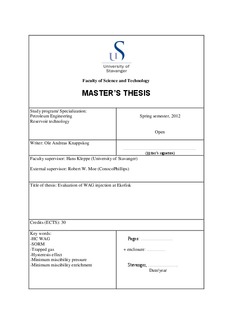| dc.contributor.author | Knappskog, Ole Andreas | |
| dc.date.accessioned | 2012-11-09T09:59:57Z | |
| dc.date.available | 2012-11-09T09:59:57Z | |
| dc.date.issued | 2012 | |
| dc.identifier.uri | http://hdl.handle.net/11250/183466 | |
| dc.description | Master's thesis in Petroleum engineering | no_NO |
| dc.description.abstract | In the North Sea many fields are water flooded. Subsequent to water flooding large amounts of water flood residual oil will be left in reservoirs. The challenge is how to improve the oil recovery. On the Ekofisk field such a challenge is to be addressed. The entire reservoir on the Ekofisk field is currently water flooded. The current plan is to continue water injection until the end of license in 2028. To improve oil recovery, EOR mechanisms have been proposed. The EOR mechanism hydrocarbon water-alternating gas has shown good potential and will be studied in this thesis.
The main purpose of this thesis is to evaluate WAG injection at Ekofisk. A number of factors may affect WAG performance, in this study the importance of some of these will be evaluated through simulation work. Miscibility evaluation is performed using a slim-tube simulation model. Mechanistic models are further used to evaluate other key parameters such as trapped gas saturation, hysteresis effect, fracture-matrix system and SORM. Finally a sector model is used to optimize WAG ratios and WAG slug sizes, and to make a comparison of WAG scenarios to a water flood case.
The slim-tube simulation work resulted in the conclusion to use immiscible WAG injection by dry hydrocarbon gas, because of high minimum miscibility pressure and minimum miscibility enrichment.
Mechanistic simulations indicated that trapped gas and SORM should be included in WAG-modeling to avoid over prediction of recoveries for a WAG applications.
Sector simulations showed incremental oil potential to the water flood case for all WAG scenarios. WAG ratio of 1 to 2 gave the largest increase with 8.4 million BOE. Increasing WAG ratio showed decreasing potential. Similar, the WAG slug size of 0.4 pore volumes was best with 4.4 million BOE incremental to the base case. WAG slug sizes showed decreasing potential with decreasing slug sizes.
The results from the sector model indicated the need of optimization of the total volume of gas injected for the WAG application, which is recommended for further studies, together with introducing local grid refinement to avoid numerical dispersion and instability problems. | no_NO |
| dc.language.iso | eng | no_NO |
| dc.publisher | University of Stavanger, Norway | no_NO |
| dc.relation.ispartofseries | Masteroppgave/UIS-TN-IPT/2012; | |
| dc.subject | petroleumsteknologi | no_NO |
| dc.subject | HC-WAG | no_NO |
| dc.subject | SORM | no_NO |
| dc.subject | trapped gas | no_NO |
| dc.subject | hysteresis | no_NO |
| dc.subject | minimum miscibility pressure | no_NO |
| dc.subject | minimum miscibility enrichment | no_NO |
| dc.subject | reservoarteknologi | no_NO |
| dc.title | Evaluation of WAG injection at Ekofisk | no_NO |
| dc.type | Master thesis | no_NO |
| dc.subject.nsi | VDP::Technology: 500::Rock and petroleum disciplines: 510::Petroleum engineering: 512 | no_NO |
| dc.source.pagenumber | 138 | no_NO |
